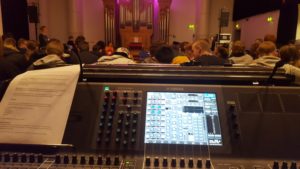On Thursdays at work there is a class for the people on our performance module, occasionally we invite working professionals in to give performance masterclasses and these follow a performance, open to the public.
Tech Rider
One week I was given a tech rider on the Tuesday for Thursdays Concert and didn’t really know what to make of it. It seemed quite specific compared to what I’m used too, not that I’m complaining, I love it when they include details of their own instruments and a stage plot including power requirements for pedal boards etc.
There were a few things that they asked for that I made the decision not to supply. They had requested an acoustic piano if there was one available mic’d with 2 414’s; In the hall that we used we have 2 grand pianos but I decided to use but in my experience, acoustic pianos cause nothing but mud in a mix if the stage is too small, the open 414s pick up the drums that were in very close proximity very well causing phasing problems when you bring the piano or the overheads up too much. The university also has a Rolland RD-300 that I’m fond of for its weighted keys and solid piano sound.
There were also places where they deviated from their channel list but this is something to be expected in 90% of situations. Always keep a couple of 57s in the bag for when they turn up with something unexpected. The channel list included an extra SM57 for misc percussion, a DI for a kaos pad and an SM57 for a guitar amplifier. None of these 3 things were needed in the end but they did have a number of other instruments, they used an accordion, a banjo and a 12 string acoustic that was played by both the bass player and the keys player at diffrent points in the set.
Set Up
I began loading in the PA at 9:00, aiming for an 11:15am sound check and rehearsal for a 13:15 concert. I had assistance from one of my colleague, we began by bringing the mixing desk, the rack, the monitors, all the mic stands and a trolley of cables upstairs to the hall. This enabled us to quickly get the infrastructural work done. We tipped the CL5 on to its stand, ran the cat5 multicore to the rack and plugged in the FOH speakers. This meant we could test everything else as we went to avoid discovering an issues too late in the day.
Next we brought in the drum kit as specified in the rider and the keyboard that we had settled on. At the same time we got all of the wedges that had been requested. The last thing that we did was to set up all of the microphones and we were very close to the wire at this point. We had tested all of the outputs, so now we line checked all of the inputs.
The Tech Rider had also requested lights; in this venue you can choose either to use presets on the wall or to bring out a lighting desk and have something a bit more flexible, with the extra time we had with the band being late we brought out the lighting desk and powered everything up. Very frustratingly we found that one of the freznels wasn’t receiving DMX, it was on full the whole time, fortunately it was pointed at the stage so we planned the lighting around this.
Sound Check and Concert
The band didn’t arrive promptly at all. One person came in briefly at 11:45 and told me some changes, another one emerged at 12:15 so I decided to set gain with people as and when they appeared and get a rough monitor mix sorted out then, I was still holding out for a proper sound check but this didn’t happen at all. I line checked everyone but the drummer, but with them being so late the first full song I heard was with the audience in and with the lights down. This was a fun job though, despite the obvious challenges on the day with so many changes and without a proper sound check I had a positive response from several colleagues. The mix for the first song was on the dry side with while I was getting to grips with the piano being used as the bass and the bass being used as a lead guitar. The musicians had a very unique style and produced a variety of different effects, the drummer was playing something rocky one minute, used what looked like drift wood the next then his hands for another song. I had been reluctant to use as many microphones as were on their channel list for the drums but they were all needed and I used every mic on the stage at different points to help connect the band and their ideas to the audience.
It was nice to go back to mixing right at the deep end. Really moving faders a lot to pull different things out as you hear them. You can get distracted so easily with all of the effects you can use on a large digital mixing console but and in their place they are great and can move a mix on to the next level, but you can’t have your entire attention taken by the compression on the snare during a mix when there might be a surprise banjo solo in the next bar. That’s a strange example but only to a point, you might not miss a banjo solo but if you are completely focused you might miss a sweet piano counter melody. Be ready to move the faders, the details are only worth bothering with if they fit in the big picture.

0 Comments